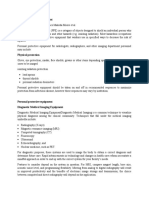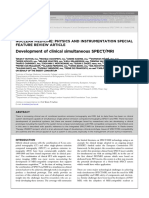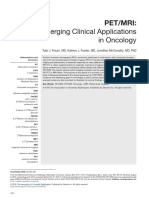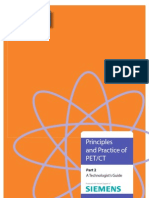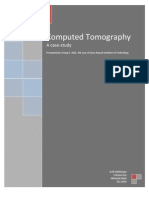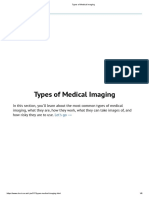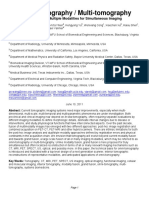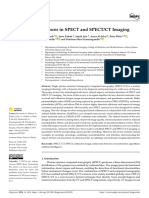PET/MRI Technology: PET (Or Positron Emission Tomography)
PET/MRI Technology: PET (Or Positron Emission Tomography)
Uploaded by
s_nugrozzCopyright:
Available Formats
PET/MRI Technology: PET (Or Positron Emission Tomography)
PET/MRI Technology: PET (Or Positron Emission Tomography)
Uploaded by
s_nugrozzOriginal Description:
Original Title
Copyright
Available Formats
Share this document
Did you find this document useful?
Is this content inappropriate?
Copyright:
Available Formats
PET/MRI Technology: PET (Or Positron Emission Tomography)
PET/MRI Technology: PET (Or Positron Emission Tomography)
Uploaded by
s_nugrozzCopyright:
Available Formats
PET/MRI Technology
PET/MRI is a new imaging modality, where the camera (or detector) used to image the PET
has been engineered to fit and function within the bore of the MRI. This allows for the
simultaneous acquisition of both PET and MRI data while the patient is in the scanner.
PET (or positron emission tomography) is an imaging modality that is used to detect the
presence of a specific type of radiation (ie positrons). We take advantage of this, by labeling
small molecules with positron emitters. The most common approach is to label glucose
(sugar) with F18 (radioactive fluorine); this is termed FDG (fluorodeoxyglucose) to describe
the injected radiotracer. Since the late 1990s, FDG PET/CT has been the cornerstone of
oncologic imaging.
MRI (or magnetic resonance imaging) is a noninvasive tool for imaging that does not require
the use of ionizing radiation. MRI uses unique properties of magnetic fields and resonance to
image water protons in the body. This technique has developed into a powerful tool for
discriminating soft tissues within the body, and is now commonly used for numerous
applications.
In order to make PET/MRI feasible, significant technological hurdles had to be over
come. The major issue is with the PET detector itself. In PET/CT the crystals detect photons
by releasing electrons, which results in a cascade within a photomultiplier tube. This
technology does not function within a PET/MRI as the electrons would be displaced due to
the strong magnetic field. Therefore new detectors had to be engineered that can function
with high fidelity within a clinical 3.0T magnet. This was solved by using what is termed
silicon photomultipliers.
Numerous other engineering hurdles had to be developed as well, including solving
attenuation correction issues, preventing heating of the detectors, workflow considerations
and minimizing interplay between MR imaging and PET acquisition.
The PET/MRI installed at UCSF is a GE Healthcare Signa 3.0T time-of-flight PET/MRI. It
is the first clinical time-of-flight PET/MRI installed in the United States, and has unparalleled
imaging capabilities. It has a 60 cm bore, identical to the majority of 3.0T magnetics
available. The PET detectors are only 5 cm wide and narrow the bore of the original magnet
from 70 cm to 60 cm. The PET detector uses a 25 mm deep lutetium base scintillator with a
25 cm z-axis field of view for the PET detector. The detectors have a sensitivity of 21
cps/kBq. Every MR sequence that is available on our clinical 3.0T magnets is available on
the PET/MRI, meaning that there is no loss in MRI imaging when simultaneous acquisitions
are performed.
PET/MRI is a first-of-its-kind imaging technology approved by the FDA in November
2014. This combined technology is used for the diagnosis, staging and treatment of a variety
of conditions, including cancer, neurological, oncological and musculoskeletal diseases.
PET/MRI provides high-quality images while reducing patient exposure to radiation. Thomas
Hope, MD, assistant professor in residence at UCSF’s Department of Abdominal Imaging
and Nuclear Medicine, has been instrumental in both leading high-level research that
demonstrated the effectiveness of this technique, and then moving this new technology from
bench to bedside (from research labs to the patient-care environment.) Here, he addressed a
key benefit of this new technology -- reducing radiation exposure.
“The PET/MRI has the best PET detectors in modern imaging. That means we are able to use
a lower dose of injected radiotracers. Time of Flight (ToF) detectors, the first such equipped
PET/MRI available in the United States, provide improved images with lower doses of
radiation because of the heightened image sensitivity.”
Additionally, he explained, “With PET/MRI, there is no CT component, so there’s no
radiation. Instead of using radiation to make an image, the MRI uses varying magnetic
fields.”
“Reducing radiation is important to all patients, but especially pediatric patients because they
are more likely to develop secondary cancers throughout their lives,” said Dr. Hope. The
same concern is true among patients requiring repeat imaging because of the long-term nature
of their condition, such as lymphoma. “Because we don’t fully understand the risk of
radiation, it’s important to minimize it as much as possible.”
Thomas Hope, MD, is an assistant professor in residence in the Abdominal Imaging
and Nuclear Medicine sections at UCSF and the San Francisco Veterans Affairs
Medical Center. In 2007, he received his medical degree from Stanford University
School of Medicine and he completed a one-year internship at Kaiser Permanente,
San Francisco. From 2008-2012, Dr. Hope completed a residency in Diagnostic
Radiology at the University of California, San Francisco, followed by a clinical
fellowship in Body MRI and Nuclear Medicine from Stanford Medical Center in 2013.
You might also like
- History and Future Technical Innovation in Positron Emission TomographyNo ratings yetHistory and Future Technical Innovation in Positron Emission Tomography18 pages
- A Digital Preclinical PET/MRI Insert and Initial Results: Abstract - Combining Positron Emission Tomography (PET)No ratings yetA Digital Preclinical PET/MRI Insert and Initial Results: Abstract - Combining Positron Emission Tomography (PET)13 pages
- Full PET CT in Lung Cancer 1st Edition Archi Agrawal PDF All Chapters100% (3)Full PET CT in Lung Cancer 1st Edition Archi Agrawal PDF All Chapters62 pages
- Healthcare Sector:: 1.detection and Diagnosis 2.workflow 3.imaging and ItNo ratings yetHealthcare Sector:: 1.detection and Diagnosis 2.workflow 3.imaging and It14 pages
- Nguyễn Thái Hoàng Duy Ksor Y Linh Thư Nguyễn Đỗ Thuý HằngNo ratings yetNguyễn Thái Hoàng Duy Ksor Y Linh Thư Nguyễn Đỗ Thuý Hằng12 pages
- PET MRI Emerging Clinical Applications in OncologyNo ratings yetPET MRI Emerging Clinical Applications in Oncology17 pages
- What The General Dental Practitioner Should Know About Cone Beam Com-Puted Tomograph TechnologyNo ratings yetWhat The General Dental Practitioner Should Know About Cone Beam Com-Puted Tomograph Technology8 pages
- Assessment 4 - Research - From Quanta To QuarksNo ratings yetAssessment 4 - Research - From Quanta To Quarks2 pages
- Performance and Application of The Total-Body PET/CT Scanner: A Literature ReviewNo ratings yetPerformance and Application of The Total-Body PET/CT Scanner: A Literature Review15 pages
- GL Principles and Practice of PET-CT Part 2No ratings yetGL Principles and Practice of PET-CT Part 2166 pages
- Physics She Task Attempt 2 by Michael WrightNo ratings yetPhysics She Task Attempt 2 by Michael Wright6 pages
- Combined SPECT/CT and PET/CT For Breast ImagingNo ratings yetCombined SPECT/CT and PET/CT For Breast Imaging9 pages
- Designing of High-Volume PET - CT Facility With Optimal Reduction of Radiation Exposure To The Staff - Implementation and Optimization in A Tertiary Health Care Facility in India - PMCNo ratings yetDesigning of High-Volume PET - CT Facility With Optimal Reduction of Radiation Exposure To The Staff - Implementation and Optimization in A Tertiary Health Care Facility in India - PMC18 pages
- Role of Gamma Camera Components in Radiological DiagnosisNo ratings yetRole of Gamma Camera Components in Radiological Diagnosis7 pages
- Positron Emission Tomography: Presented by Kalyani ShindeNo ratings yetPositron Emission Tomography: Presented by Kalyani Shinde25 pages
- PET CT in Lung Cancer 1st Edition Archi Agrawal all chapter instant download100% (1)PET CT in Lung Cancer 1st Edition Archi Agrawal all chapter instant download55 pages
- I.21.109 Sayan Samanta Presentation On PET CTNo ratings yetI.21.109 Sayan Samanta Presentation On PET CT20 pages
- For The First Time, MR and PET Are One.: Local Contact Information in The USANo ratings yetFor The First Time, MR and PET Are One.: Local Contact Information in The USA14 pages
- Biology Sales Poster - Grade 9 Biology Category DNo ratings yetBiology Sales Poster - Grade 9 Biology Category D10 pages
- Site Planning and Radiation Safety in The PET FacilitNo ratings yetSite Planning and Radiation Safety in The PET Facilit13 pages
- Quantitative Comparison of PET Performance-SiemensNo ratings yetQuantitative Comparison of PET Performance-Siemens15 pages
- Pet Scan CT Scan: (Positron Emission Tomography) (Computed Tomography Scan)No ratings yetPet Scan CT Scan: (Positron Emission Tomography) (Computed Tomography Scan)3 pages
- Full Download PET CT in Lung Cancer Clinicians Guides to Radionuclide Hybrid Imaging Archi Agrawal (Editor) PDF DOCX100% (1)Full Download PET CT in Lung Cancer Clinicians Guides to Radionuclide Hybrid Imaging Archi Agrawal (Editor) PDF DOCX50 pages
- Positron Emission Tomography - Computed Tomography (PET/CT)No ratings yetPositron Emission Tomography - Computed Tomography (PET/CT)8 pages
- Nano Platform For Positron Emission TomographyNo ratings yetNano Platform For Positron Emission Tomography4 pages
- Textbook of Urgent Care Management: Chapter 35, Urgent Care Imaging and InterpretationFrom EverandTextbook of Urgent Care Management: Chapter 35, Urgent Care Imaging and InterpretationNo ratings yet
- Medical Guidelines 1. Medical Personnel 1.1 Appointments/servicesNo ratings yetMedical Guidelines 1. Medical Personnel 1.1 Appointments/services2 pages
- 2022 SOMALIA Integrated Household Budget Survey: (Sihbs)No ratings yet2022 SOMALIA Integrated Household Budget Survey: (Sihbs)84 pages
- CRS Management EPOS2020 - Prof Qadar (FN), 27-09-20, Perhati Kalsel-TengNo ratings yetCRS Management EPOS2020 - Prof Qadar (FN), 27-09-20, Perhati Kalsel-Teng63 pages
- Assessment and Management of Women During Post-Natal Period0% (1)Assessment and Management of Women During Post-Natal Period82 pages
- Preliminary Calculations For The Design of A BeamNo ratings yetPreliminary Calculations For The Design of A Beam2 pages
- Practical Soil Microbiology: Fourth Stage University of Baghdad Collage of Science Department of BiologyNo ratings yetPractical Soil Microbiology: Fourth Stage University of Baghdad Collage of Science Department of Biology22 pages
- A Review of The Ethnopharmacology, Phytochemistry and Pharmacology of Rauwolfia TetraphyllaNo ratings yetA Review of The Ethnopharmacology, Phytochemistry and Pharmacology of Rauwolfia Tetraphylla8 pages
- Ch. 6: Chemical Equilibrium: Updated Oct. 5, 2011: Minor Fix On Slide 11, New Slides 31-42No ratings yetCh. 6: Chemical Equilibrium: Updated Oct. 5, 2011: Minor Fix On Slide 11, New Slides 31-4242 pages
- sergii,+Journal+editor,+03Hamed Articulo 2No ratings yetsergii,+Journal+editor,+03Hamed Articulo 28 pages
- RFP - RFP - 1809 - Construction of 250 Villas in Al Samha (Musanada's E-Procurement Portal)No ratings yetRFP - RFP - 1809 - Construction of 250 Villas in Al Samha (Musanada's E-Procurement Portal)215 pages
- Aggressive Driving Should Be Avoided ENGLISH 10No ratings yetAggressive Driving Should Be Avoided ENGLISH 106 pages
- Roopa Talwar Lecturer Dept. of Hospital Administration JNMCNo ratings yetRoopa Talwar Lecturer Dept. of Hospital Administration JNMC44 pages
- Mohd Fahmi Bin Ahmad Jamizi Behp 22106112 Assignment 1No ratings yetMohd Fahmi Bin Ahmad Jamizi Behp 22106112 Assignment 116 pages
- Volume 2 Part 3 - Mechanical SpecificationsNo ratings yetVolume 2 Part 3 - Mechanical Specifications534 pages













